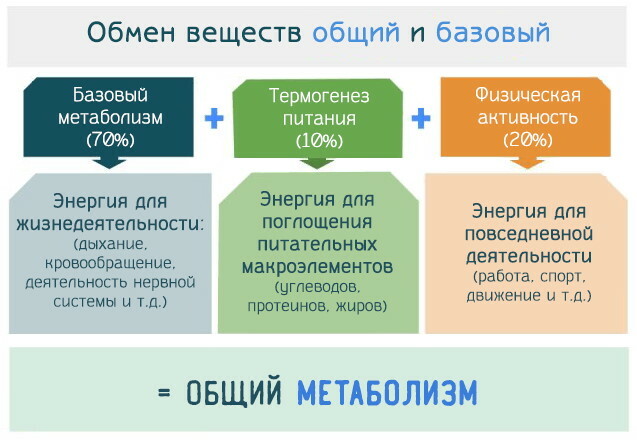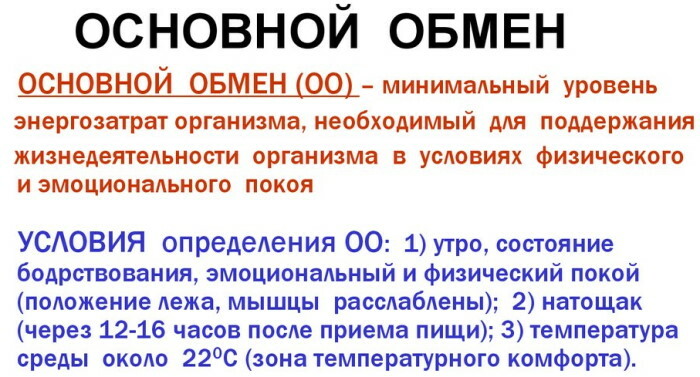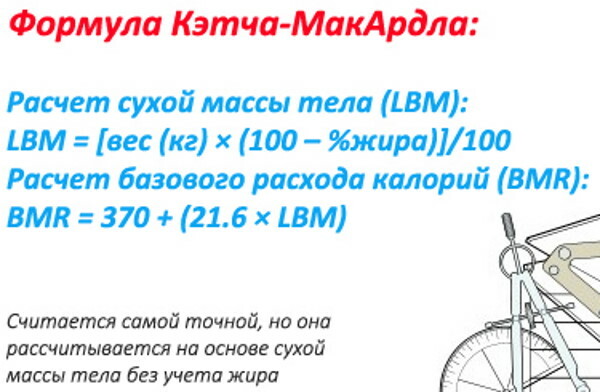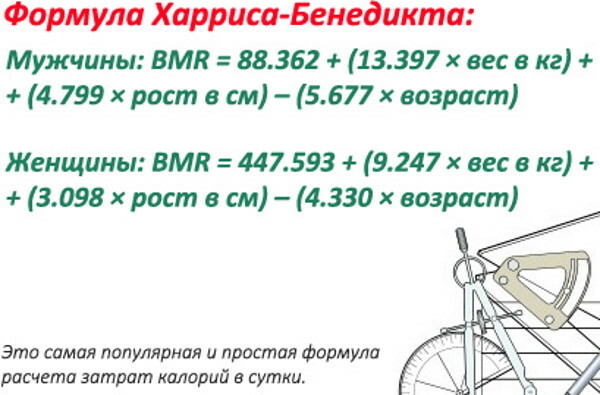Content
- What is Basal Metabolism?
- What is a basal metabolic rate (BMR) calculation for?
- Norm depending on age group and gender
- How to measure BMR?
- Basal metabolic rate calculator based on gender, age and weight
- How to Calculate Your Base Metabolism?
- Larn's formulas
- Harris and Benedict's formulas
- Factors Influencing UBM
- Basal Metabolism Videos
Basal metabolism or basal metabolism is called the minimum required amount of energy to maintain the vital activity of a biological organism. This concept reflects the level of nutrient consumption in the absence of intense physical activity.
These physiological processes support the vital functions of the body.
A significant proportion of the energy released as a result of metabolic reactions of the basal type is spent on:
- palpitations;
- respiratory activity;
- the functioning of the endocrine glands;
- thermoregulation;
- digestion;
- the work of the hepatobiliary mechanism;
- renal activity.
Basal metabolism is the main material metabolism, determined during wakefulness, during muscular and emotional rest, at a comfortable ambient temperature within + 18... + 22 ° С.
The transformation of endogenous compounds and nutrients is a constantly occurring biochemical change in a living organism, affecting tissue structures, cells, biological fluids.
The key goal of basal metabolism is to process food into energy necessary to maintain life.
In the process of basic exchange:
- protein and other proteins are synthesized;
- fats are broken down;
- carbohydrates are released;
- some amino acids are produced;
- nitrogen waste is removed as a by-product of such physiological reactions.
Basal metabolism is either primary or secondary. Each has its own complex purpose. Primary metabolic reactions are aimed at the implementation of basic biochemical reactions.
They determine the development, vital activity and growth of the organism.

As a result of such processes, the following are generated:
- saccharides are the main source of energy;
- lipid substances that make up the basis of the subcutaneous tissue, the protective capsule of some vital internal organs;
- amino acids;
- nucleic acids that store, transmit and implement genetic information.
Secondary basal metabolism - biochemical reactions in certain structural groups.
They are aimed at the production and breakdown of specific non-protein substances:
- immunocompetent compounds;
- hormones;
- pigments;
- building molecules that form the skeletal framework, hair, nail plates.
The rate at which food is processed into energy is called the metabolic rate. This indicator is individual. It depends on the characteristics of the functioning of the nervous system and the endocrine mechanism, the current state of the internal organs.
What is a basal metabolic rate (BMR) calculation for?
Such calculations are important for determining the number of calories burned daily at rest, emotional stress, and physical activity. The calculation is used by athletes, representatives of various sports. Definition of BMR is necessary for the treatment of metabolic disorders.
The technique is used for body shaping, with morbid obesity. Knowing the rate of your own basal metabolic rate is important for drawing up a dietary ration, increasing muscle mass, and acquiring the desired anthropometric parameters.
To maintain the optimal body weight based on the UMB calculation, the amount of calories consumed is the same as the one burned.
Basal metabolism provides:
- hormonal synthesis;
- secretion of enzymes;
- cognitive function;
- falling asleep;
- immune support;
- the correct proportion of anabolic reactions and catabolic processes.
With such violations, the UBM indicator is used to draw up effective therapeutic tactics and determine a treatment plan. Basal metabolism is regulated by the hypothalamus.
The calculation of the rate of metabolic reactions is performed in the diagnosis of functional disorders of this part of the cerebral zone. The indicator is distinguished by phenotypic flexibility.
The function lends itself to reversible regulation by medication and physiotherapy. The rate of metabolic reactions is influenced by endogenous and exogenous factors.
Basal metabolic processes are accelerated in some pathological conditions:
- elevated body temperature;
- burn injuries;
- bone fractures;
- infectious and inflammatory processes;
- fever.
UBM changes depending on the phase of the menstrual cycle, at different periods of pregnancy. Calculation with the necessary amendments is used to determine the cause of sudden weight loss, or vice versa, abnormally rapid weight gain.
Norm depending on age group and gender
Basal metabolism is an indicator of the rate of basic material metabolism, which is considered a constant value for each organism in conditions of complete rest and comfortable temperature.
UBM serves as an integral value of the intensity of redox reactions in tissue and cellular structures. The rate depends on the type and nature of external influences on the body.
The level of basal metabolism changes with excessive or excessive saturation of the body with food, physiologically active substances. The rate of such processes is influenced by physical activity and climatic factors.
UBM depends on gender, age, functional state of the body. The approximate daily calorie consumption for an adult is estimated at 1600-1700 kcal.
Approximate indicators of the basal metabolic rate for adults of different ages and sex are presented in the table.
| Age, years | Standard indicator of basal metabolic rate, kcal per 1 m2 body area per hour | |
| Men | Women | |
| 16-18 | 43,0 | 40,0 |
| 18-20 | 41,0 | 38,0 |
| 20-30 | 39,5 | 37,0 |
| 30-40 | 39,5 | 36,5 |
| 40-50 | 37,0 | 35,5 |
| 50-60 | 35,3 | 32,7 |
In children under 16, the basal metabolic rate is unstable and subject to significant fluctuations under the influence of numerous factors. The daily calorie requirement of infants, according to various research data, is 46-54 kcal / kg of body weight.
In the first months of life, the thermoregulation mechanism is actively formed, which requires an increased amount of energy. Heat production is constantly increasing, reaching its maximum value at the beginning of the second year after birth.
During this period, the thermogenesis of the child exceeds the same indicator for adults by 1.5-2 times. In different phases of life, basal metabolism sometimes accelerates, then slows down. As the body develops, the basal metabolism stabilizes and at the age of 16 reaches standard values typical for adults.
The increased rate of metabolic processes in children is due to a large volume of protoplasmic mass, significant reactivity, and rapid growth of skeletal structures and tissue structures.
How to measure BMR?
Minimal neural activity is required to obtain a reliable and objective laboratory value. The subject is immersed in a state of complete rest. For the calculation, a specially developed Harris-Benedict, Mifflin-San Geor or Kacha-Makardla formula is used.
The first one was brought out in 1984. American, physiologist and nutritionist, by whose name she is named. In 1990 g. a more accurate and up-to-date formula for calculating the basal metabolic rate was presented. It was authored by a group of American nutritionists led by Dr. Mifflin and St. Geor. This formula is considered to be the most accurate.
The Kacha-Makardla scheme appeared relatively recently. Its difference from other used formulas lies in the possibility of calculating the energy costs of the body in a dream. It takes into account the volume of muscle mass and the activity of muscle structures in an unconscious state. The technique is suitable for professional athletes. Basal metabolism slows down with age and as lean body mass decreases.
The body's energy consumption is significantly increased by strength and aerobic exercise. The Kacha-Makardla formula allows you to accurately calculate this indicator. Graphically, it is written as follows: BMR = 370 + 21.6 (1-F) x W.
Letter F means the percentage of body fat from the total body weight, W - weight in kg. The updated Harris-Benedict equation for calculating the basal metabolic rate in men is as follows: BMR = 13.397xW + 4.799xH-5.667xA + 88.362.
Letter H - height in cm, A - age. The formula for women differs in the entered coefficients, but not in the calculation principle. It looks like this: BMR = 9.247xW + 3.098xH-4.330xA + 447.593.
Basal metabolism can be calculated using the Mifflin-Saint Geor formula. This equation is used to determine the daily calorie requirement. The formula for men looks like this: BMR = 10xW + 6.25xH-5xA + 5. The equation for women differs only in the last numerical factor. It has a value of -161.
Basal metabolic rate calculator based on gender, age and weight
About 70% of the energy obtained from food is consumed by vital physiological processes. About 20% is accounted for by nervous activity and physical activity.
The remaining 10% consume postprandial thermogenesis reactions associated with digestion, breakdown and assimilation of food. All of these metabolic reactions require oxygen and coenzymes.
With regard to the level of basic metabolism, a significant proportion of energy resources are spent by enzymatic processes, regulation of osmotic pressure in tissues and blood vessels.
An energy resource is needed to evacuate carbon dioxide released as a result of the Krebs cycle.
The UBM calculator takes into account the following factors:
- The initial rate of metabolic reactions. The indicator is unchanged for an individual organism. It is determined by the ratio of mobility to the excess amount of energy released.
- Saturation of blood with hormonal substances. In diabetic pathology or dysfunction of the gastrointestinal tract, the basal metabolism proceeds more slowly than the established norm.
- Gender. In men, metabolic reactions occur faster than in women, due to the greater volume of muscle tissue and less fat. A 10% increase in speed gives testosterone. In women in the menopausal phase, the activity of the thyroid gland decreases, which causes weight gain. There is a hormonal imbalance that worsens the regulation of glucose, insulin, and hycagon - catalysts of metabolic reactions.
- Body mass. A slender constitution accelerates the basal metabolism. Being overweight indicates a slowdown in metabolic reactions.
-
Age. A natural slowdown in basal metabolism begins after age 40. At the age of 25, bone growth stops. From this point on, the basal metabolic rate slows down by about 2% every 10 years.

In the formula for calculating UBM enter the coefficient of physical activity from 1.2 for a passive lifestyle to 1.9 for professional athletes.
To obtain objective and reliable results, it is necessary to know exactly a lot of anatomical and physiological parameters. You can roughly calculate your own basal metabolic rate using a simple formula.
Basal metabolism is a physiological characteristic of the body that is subject to changes depending on:
- floor;
- age;
- body constitution;
- type of physical activity;
- the presence of pathologies.
The formula for the approximate calculation of the basal metabolic rate for an average 25-year-old girl weighing 50 kg and a height of 165 cm is as follows: 10.4x50 + 615x1.65-282.
According to the results obtained, she needs to consume 1253 kcal daily to maintain normal functioning of the body. The above formula does not take into account the type of physical activity, individual endocrine activity, hormones.
A constant and personal parameter is food thermogenesis. About 10% of the consumed energy resources are spent on its maintenance. Another important factor affecting BMR is the rate of breakdown of proteins, fats, and carbohydrate compounds.
The former are the most energy consuming. For the processing of protein substances, approximately 20-30% of their calorie content is spent. For the assimilation of carbohydrates, 6-8% is required, fats - 2-3%.
What matters is the type of food, which is taken into account in special formulas for calculating UBM by assigning an appropriate coefficient. High-protein diets are used for body shaping due to the high energy consumption of such substances.
In addition to the high calorie consumption, such compounds instill a false sense of satiety, which makes it easier to adhere to the diet.
Lipid nutrients are classified into:
- saturated;
- polyunsaturated;
- monounsaturated;
- food cholesterol;
- trans fats.
Each variety requires its own amount of energy to be processed, which affects the basal metabolic rate. The accuracy of the calculation is ensured by an individual and multifactorial approach. Below are the current options for calculating UBM.
Larn's formulas
The counting method takes into account the age category, which affects the rate of basal metabolic reactions. For men 18-29 years old, use the following Larn formula: 15.3 x weight in kg + 679. For women of the same age, only the coefficients change.
The calculation is made by multiplying the body weight by 14.7. The coefficient 496 is added to the result obtained. To calculate the level of basal metabolism in men aged 30-59 years, the body weight in kg is multiplied by 11.6 and added to the resulting numerical value 879.
For women of a similar age, the coefficients are 8.7 and 829, respectively. Such formulas characterize the relative accuracy, since individual physiological and pathological factors that can change the rate of metabolic reactions in a significant range.
In clinical medicine, the definition of UBM is of diagnostic value when choosing tactics for the treatment of numerous gastroenterological diseases, endocrine pathologies, and digestive disorders.
Nutritionists and doctors of other profiles use updated tables, where the maximum number of factors is taken into account, correction factors are applied. In addition, calorimetric techniques are used, based on the recorded indicators of gas exchange.
They allow the calculation and characterization of energy losses with thermal effects inherent in individual metabolic reactions reflecting the activity of organs, cytological units, intracellular organelle.
Harris and Benedict's formulas
Basal metabolism is a physiological characteristic that must be calculated based on the type of physical activity. For such calculations, Harris and Benedict's formulas are used.
Each type of physical activity is assigned an individual coefficient, by which the obtained UBM result is multiplied. For men, the following formula is used: 66.5 + (13.5 x weight in kg) + (5 x height in cm) - (6.75 x age).
When calculating the female level of basal metabolism, the first correction factor remains unchanged, the rest acquire values of 9.55, 1.8 and 4.7, respectively.
The result obtained reflects the approximate daily consumption of energy resources in calories. To clarify the UBM parameters, the calculated value is multiplied by an additional and independently determined coefficient of physical activity.
With a sedentary lifestyle, this figure is 1.2. For the average person, a factor of 1.375 is used. For those who visit the gym, do daily morning runs, or are engaged in hard physical labor, it is recommended to multiply the result by 1.725.
Factors Influencing UBM
In addition to the age-related, sexual, physiological reasons described above, a large number of behavioral, pathological, and genetic factors affect the rate of basal metabolism.
What matters are:
- Specific dynamic assimilation of nutrients. The substances contained in food are usually degraded within 5-6 hours, but for each person this process has a different speed, which is reflected in the UBM indicator.
- Ambient temperature. Long-term exposure to cold speeds up metabolic processes. When the temperature indicator drops by 10 ° below the set comfort level, the basal metabolic rate increases by 2.5%.
- Circadian rhythms. Basal metabolism changes depending on the time of day, on days of the week, seasons. In sleep, basal metabolism slows down by 13% in comparison with the period of wakefulness due to relaxation of skeletal muscles.
- Taking medicines. The natural course of metabolic processes changes the consumption of diuretic drugs, oral contraceptives, glucocorticosteroids, venotonic and many other drugs.
The tone of the autonomic and sympathetic parts of the nervous system has a significant effect on the rate of basal metabolism. The neurotransmitters they produce play an important role in thermogenesis. A pronounced change in the basal metabolism is observed with damage to the anterior lobe of the pituitary part of the brain.
Of the pathological factors of influence, tumor processes in chromaffin tissues are noted. Such neoplasias secrete adrenaline and norepinephrine, which sharply accelerate the basal metabolism. A change in UBM causes traumatic damage or tumor damage to the autonomic centers of the diencephalic zone.
Surgical amputation of sympathetic plexuses and degeneration of the adrenal medulla lead to a decrease in the rate of basal metabolism. The hormones secreted by them are capable of affecting not only the functions of internal organs, but also primary thermogenesis.
The biochemical mechanism of this effect is not fully understood. A violation of the production of thyroid hormone leads to a change in the rate of basal metabolism. This physiologically active compound performs specific regulation of tissue respiration and energy metabolism.
How to calculate your metabolism correctly:



